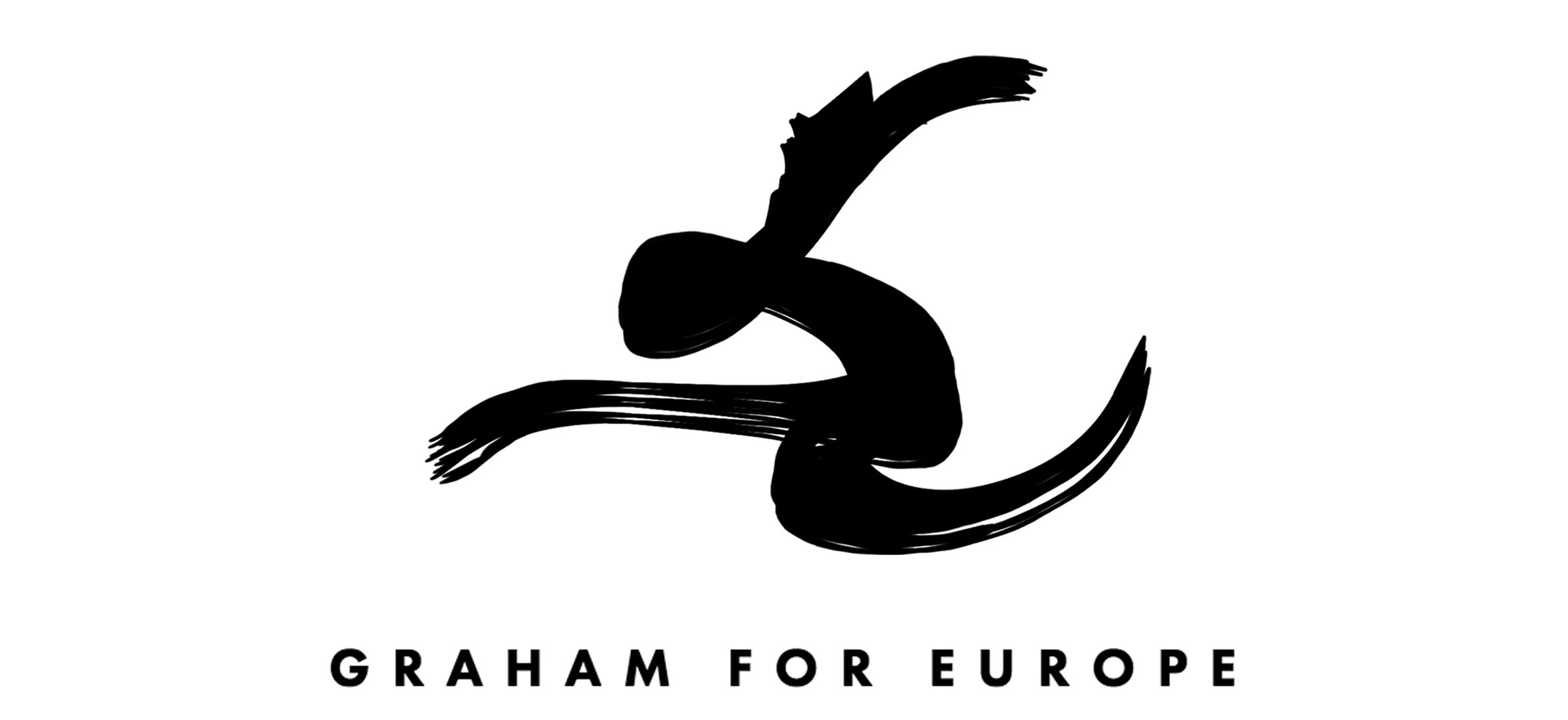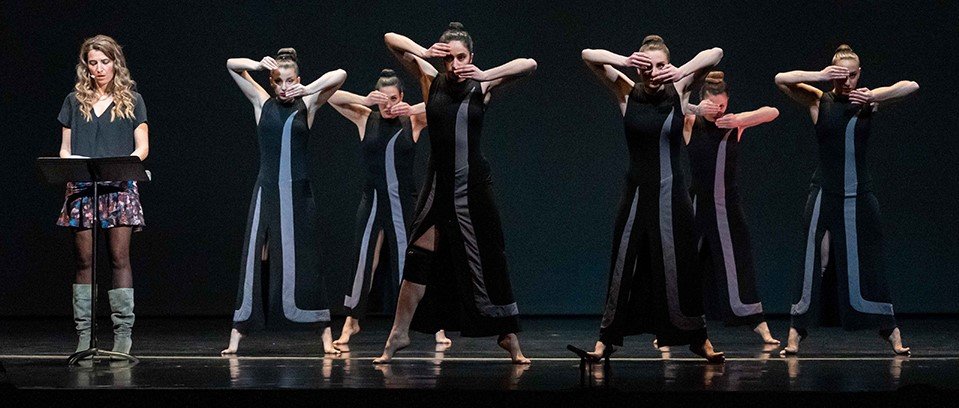🎭 Martha Graham and Greek Myth Travels to Paris, France
Martha Graham and Greek Myth Travels to Paris, France
by Nina Papathanasopoulou
The American artist Martha Graham’s prodigious and revolutionary body of work has long been celebrated by Europeans. In Greece in particular, the Graham dance technique has for a long time formed a core part of all young dancers’ training at the Greek National School of Dance in Athens. Graham For Europe, founded in 2017 to promote and honor Graham’s legacy, is a relatively young organization, but dedicated to its vision. So I was truly delighted to receive an invitation to take our collaborative presentation “Martha Graham & Greek Myth,” conceived in Greece, to Paris, France, for Graham For Europe’s first ever Summer Intensive Program this past July.
The Martha Graham & Greek Myth team poses before their performance at the historic Apollon Theater on the island of Syros in June 2023. Photo ©by Yannis Vavitsas.
The location was ideal - the City Hall of Paris Centre (former 3rd arrondissement) in Paris, France, a historic 19th century building constructed in the Renaissance Revival Architecture style. This inaugural Summer Intensive Program gathered together almost 100 dancers, instructors, students, researchers and dance enthusiasts from over 23 countries around the world. Participants spent up to a week in technique classes, creative workshops, a pedagogy seminar for teachers and special events surrounding the work of Graham.
From left to right: Martha Graham & Greek Myth dancers Eleftheria Iliopoulou and Mara Tsourma, project creator and speaker Dr. Nina Papathanasopoulou, Director of Graham for Europe, Rafael Molina, choreographer Penny Diamantopoulou and dancer Vassia Kolliou in front of the City Hall of Paris Centre.
My collaborator Penny Diamantopoulou, a well-known choreographer and Graham technique instructor, had been invited to participate as one of the intensive’s main instructors, alongside a number of acclaimed Graham instructors. These included the legendary Christine Dakin, who was a principal dancer with the Martha Graham Dance Company (1976-2005), as well as Associate Artistic Director of the Company starting in 1997, and co-Artistic Director from 2002-2005.
Penny Diamantopoulou at the start of the Martha Graham & Greek Myth presentation in Paris.
“Martha Graham & Greek Myth” was to be the program’s closing event. The project, which is made possible with the permission and support of the Martha Graham Center of Contemporary Dance in New York, consists of a series of presentations that integrate live dancing, photographs, images of ancient and modern artwork, and excerpts from ancient texts into an informative talk about Graham’s own reimaginings of Greek myth. The project had been performed in numerous venues in Athens, and traveled to Corfu, Kalamata, and Syros. But of course Greek myth is of interest far beyond Greece, as Graham’s own deep engagement with our heritage shows. Performing in Paris for an international group of Graham devotees and enthusiasts was an incredible opportunity for showcasing the significance and value of Greek myth, as well as the importance of cross-cultural collaborations for gaining new insights and perspectives. For this performance, I worked in Paris with Penny, three excellent professional dancers who were already veterans of our Greece-based performances, Eleftheria Iliopoulou, Vassia Kolliou, and Mara Tsourma, and also two advanced students from the intensive, Barbara Sulvic and Berenice Heger-Hedloy, who were new to our work.
Dancers Marianna Tsikmanli and Vassia Kolliou demonstrate the movements inspired by the goddess Aphrodite during the Martha Graham & Greek Myth presentation at Poreia Theater in Athens in October 2022. Photo© by Patroklos Skafidas.
Dancers Vassia Kolliou, Marianna Papakonstantinou, Marianna Tsikmanli, and Mara Tsourma during the Graham technique demonstration at the Martha Graham & Greek Myth presentation at the Apollon Theater on the island of Syros in June 2023. Photo © by Yannis Vavitsas.
Our audiences have always been eclectic: a mix of dance enthusiasts, students of Greek mythology, and the simply curious. This variety reflects the hybrid nature of the experiment. What happens when we put 20th century America and Europe into dialogue with Ancient Greece? Classical philology with modern dance? It turns out that these diverse fields have a lot to offer each other. The combination itself gives large numbers of people an entry point to the subject matter, and combining Classics and Dance is part of my ongoing efforts to make the study of Greek myth accessible and relevant to the public at large.
Dr. Nina Papathanasopoulou along with the Martha Graham & Greek Myth dancers Ioanna Tzanimi, Marianna Papakonstantinou, Natalia Kalogeropoulou, Androniki Vasili, Vassia Kolliou, and Maritina Katsimpraki showing movement from the Daughters of the Night chorus from Night Journey, Graham’s retelling of the myth of Oedipus and Jocasta. From our presentation at the Theater of the American Community Schools in March 2022. Photo © by Dimitris Mamaloukos.
The project was first inspired by my students. When I began teaching Classical Mythology at Connecticut College back in 2014, I soon realized that many had no previous knowledge of the subject. Some had read children’s versions of Greek myths or books like the Percy Jackson series which draw on mythical figures and narratives, but others were completely unfamiliar with the subject. Students were fascinated by how much one can learn about a culture via their stories. Their excitement was obvious when we studied the myths as a means for understanding the Greeks’ institutions, their values, their approach to politics, religion, and social issues. To help students see the multi-layered meaning of the myths and use them as tools for conversation and self-reflection, I also turned to modern interpretations of the myths, incorporating in my classes the study of modern thinkers and artists, and the ways that they had approached and used these myths for their own benefit, for communication, for encouraging reflection. Martha Graham, for example, to whom I am particularly drawn and have devoted part of my research, turned to Greek myth as a way to explore the psychology and emotions of women. Through these modern artists, new questions arose: are these ancient stories useful for us in our own lives? Can they, perhaps, help us in understanding our own values or what we consider significant, praiseworthy, or reproachable? Can they help us define justice and provide tools to approach issues regarding gender and sexuality? Can they help us deal with grief, pain, and the inevitability of dying?
The answer was yes. Not only were these myth students learning about the Greeks, but also about themselves.
Inspired by my students’ reactions to select modern retellings of myth and interested in transmitting my passion about ancient narratives, I experimented with making such an approach accessible to a wider audience. I thus conceived of “Martha Graham and Greek Myth”, a project combining the study of Greek literature with modern dance aimed at rekindling public interest in Greek myth and promoting appreciation for the value of modern dance. The project draws its strength from its interdisciplinary approach – combining an academic talk with dance performances – and displays how both fields could benefit from each other.
Dancer Mara Tsourma showing Graham’s prances, a movement inspired by the gait of horses during the Martha Graham & Greek Myth presentation in Paris in July 2023.
Dr. Nina Papathanasopoulou discussing Graham’s work Clytemnestra during the Martha Graham & Greek Myth presentation at the Cultural Center in Kalamata in June 2023. Photo© by Panos Tantis.
Presenting this project in Paris was instrumental for advancing the project’s goals and for exposing an international audience well-versed in dance to the academic study of Greek myth. Rafael Molina, Director of Graham for Europe, was a phenomenal host, energetic and charming. Members of the audience were in their words “spellbound” and “fascinated” by the project and expressed immense gratitude to be able to learn about Greek Myth within the context of a medium they are most familiar with: dance. Molina commented in more detail:
It is not the first time that I am exposed to an explanation, interpretation or even « dissection » of a choreography. But I never saw it happen simultaneously. As Nina analyzes the architecture, inspiration and expressiveness of the steps in Graham’s repertory, a dancer enters and demonstrates that movement. It feels like discovering the alphabet that Martha Graham uses. Then the dancers come to perform the full section of repertory and suddenly it all makes sense because our brain had had time to process the depth and significance of each part.
Such responses affirm the value of the project even for a community that is deeply familiar with Graham and confirm my belief that opening new avenues for exploring a known subject is definitely worthwhile.
The poster for the Martha Graham & Greek Myth presentation in Paris.
The Martha Graham & Greek Myth dancers perform the Daughters of the Night chorus from Graham’s Night Journey at the Cultural Center of Kalamata in June 2023. Choreography by Martha Graham. Photo © by Panos Tantis.
About Nina Papathanasopoulou
Nina Papathanasopoulou is a Professor of Classical Studies specializing in Greek Theater and Classical mythology. A dance enthusiast since the age of 10, her academic research centers on Martha Graham’s dance interpretations of Greek Myth. She has published articles on Graham’s renderings of the myths of Medea, Oedipus and Jocasta, and Ariadne and the Minotaur, and is currently working on Graham’s Clytemnestra. She earned her BA in Classics from the University of Athens in 2003 and her PhD from Columbia University in New York in 2013. From 2013 to 2019 she was Visiting Assistant Professor of Classics at Connecticut College. In 2020 she joined the Classics faculty at College Year in Athens, where she teaches Ancient Greek mythology, religion, and literature courses and runs student field trips all over Greece. She conceived of and created “Martha Graham & Greek Myth” together with Penny Diamantopoulou in 2022. The project operates with the permission and support of the Martha Graham Center of Contemporary Dance in New York.











